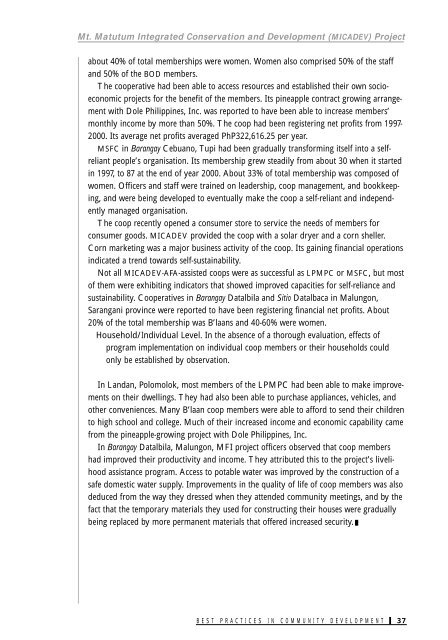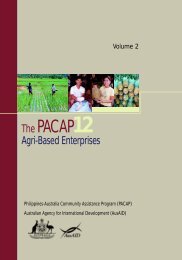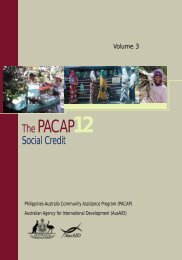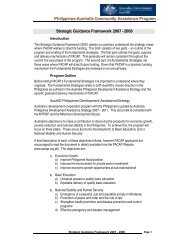The PACAP12
The PACAP12
The PACAP12
You also want an ePaper? Increase the reach of your titles
YUMPU automatically turns print PDFs into web optimized ePapers that Google loves.
Mt. Matutum Integrated Conservation and Development (MICADEV) Project<br />
about 40% of total memberships were women. Women also comprised 50% of the staff<br />
and 50% of the BOD members.<br />
<strong>The</strong> cooperative had been able to access resources and established their own socioeconomic<br />
projects for the benefit of the members. Its pineapple contract growing arrangement<br />
with Dole Philippines, Inc. was reported to have been able to increase members’<br />
monthly income by more than 50%. <strong>The</strong> coop had been registering net profits from 1997-<br />
2000. Its average net profits averaged PhP322,616.25 per year.<br />
MSFC in Barangay Cebuano, Tupi had been gradually transforming itself into a selfreliant<br />
people’s organisation. Its membership grew steadily from about 30 when it started<br />
in 1997, to 87 at the end of year 2000. About 33% of total membership was composed of<br />
women. Officers and staff were trained on leadership, coop management, and bookkeeping,<br />
and were being developed to eventually make the coop a self-reliant and independently<br />
managed organisation.<br />
<strong>The</strong> coop recently opened a consumer store to service the needs of members for<br />
consumer goods. MICADEV provided the coop with a solar dryer and a corn sheller.<br />
Corn marketing was a major business activity of the coop. Its gaining financial operations<br />
indicated a trend towards self-sustainability.<br />
Not all MICADEV-AFA-assisted coops were as successful as LPMPC or MSFC, but most<br />
of them were exhibiting indicators that showed improved capacities for self-reliance and<br />
sustainability. Cooperatives in Barangay Datalbila and Sitio Datalbaca in Malungon,<br />
Sarangani province were reported to have been registering financial net profits. About<br />
20% of the total membership was B’laans and 40-60% were women.<br />
Household/Individual Level. In the absence of a thorough evaluation, effects of<br />
program implementation on individual coop members or their households could<br />
only be established by observation.<br />
In Landan, Polomolok, most members of the LPMPC had been able to make improvements<br />
on their dwellings. <strong>The</strong>y had also been able to purchase appliances, vehicles, and<br />
other conveniences. Many B’laan coop members were able to afford to send their children<br />
to high school and college. Much of their increased income and economic capability came<br />
from the pineapple-growing project with Dole Philippines, Inc.<br />
In Barangay Datalbila, Malungon, MFI project officers observed that coop members<br />
had improved their productivity and income. <strong>The</strong>y attributed this to the project’s livelihood<br />
assistance program. Access to potable water was improved by the construction of a<br />
safe domestic water supply. Improvements in the quality of life of coop members was also<br />
deduced from the way they dressed when they attended community meetings, and by the<br />
fact that the temporary materials they used for constructing their houses were gradually<br />
being replaced by more permanent materials that offered increased security.<br />
B E S T P R A C T I C E S I N C O M M U N I T Y D E V E L O P M E N T 37







